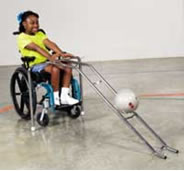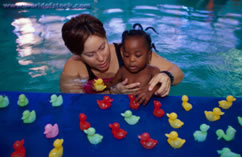
 |
|
|
||
|
|
||
| Conference/Workshop Calendar | ||
Physical
Education, Exercise Prescriptions, and Adapted Physical Activity
|
||||||||||
 Figure 1: Assistive bowling ramp |
Adapted physical activity for people with cerebral palsy is essential since the disorder is so much more a physical disability rather than a mental disability, for the most part. Positioning plays an important role in the adapted physical exercises. For example, adapting a game of bowling with an assistive ramp leading toward the standing pins is a great adaptation for a person with cerebral palsy. The exercise involves the handling of the ball, placing the ball on the top of the ramp, pushing the ball down the slope of the ramp, and feeling a sense of accomplishment once the ball knocks down the pins. If the person requires a wheelchair for locomotion, the wheelchair can be brought up close to the ramp to assist even further (See Figure 1). | |
| Furthermore, flotation devices, inner tubes, rafts, floatable or sinkable toys, and hoops can all be used in adapting an aquatics exercise regime for a person with cerebral palsy (Stopka & Bowie, 2000). Among the benefits an aquatic environment can give a person with cerebral palsy are the warm water aiding in relaxation for the muscles thus improving muscle tone (Stopka & Todorovich, 2005)."Many people with sever disabilities have jumped, walked, hopped and leaped for their first time ever, in pursuit of their special toy as it floats by them. The 80% reduction in force of gravity allows for such an achievement too take place, but the special toy is often the catalyst for this small miracle" (Stopka & Bowie, 2000, p64). All in all, adapted physical activity/exercise therapy recommendations for people with cerebral palsy can have just that, results that appear like miracles (See Figure 2). |  |
|
| Figure 2: Therapist assisting child with floatable toys. | ||
With interest in such participation increasing, it is necessary for the physicians, therapists, and families of children with special needs to understand the preparticipation evaluation, athletic options, specialized equipment, and sport-specific risks (Wind, et al., 2004). In a research study focusing on the benefits of strength training for young people with cerebral palsy, participants reported psychological benefits such as a feeling of increased well-being and improved participation in school and leisure activities (McBurney, Taylor, Dodd, and Graham, 2003). Participation in everyday activities is considered to be a vital part of an individual's development, which is related to their quality of life and future life outcomes. Research studies indicate that children with disabilities are at risk for lower participation in ordinary activities (King, Law, King, Rosenbaum, Kertoy, and Young, 2003). It is the responsibility of the caregiver and of the educator to provide the resources necessary for the person with cerebral palsy to integrate and involve themselves in the required physical activity needed to improve their overall quality of life.
In conclusion, physical education, exercise prescriptions, and adapted physical activity for people with cerebral palsy are beneficial to not only the physical, but the emotional and social improvement of that individual. Research stresses that sufficient clinician resources must be allocated to solve individual equipment and exercise problems (McBurney, et al., 2003). In other words, future health care providers and educators must act as advocates, fight for the person with cerebral palsy or the person with any disability for that matter. I agree with Stopka & Bowie (2000) in using the word "miracle." No other word could be more appropriate for the significant positive change that one can have on another person's life.
References
Ayyangar, R. (2002). Health maintenance and management in childhood
disability. Physical
Medicine and Rehabilitation Clinics of North America, 13(4), 793-821.
King, G., Law, M., King, S., Rosenbaum, P.,
Kertoy, M. K., and Young, N. L. (2003). A
conceptual model of the factors affecting the recreation and leisure
participation of children with disabilities. Physical & Occupational
Therapy in Pediatrics, 23(1), 63-90.
McBurney, H., Taylor, N. F., Dodd, K. J., and
Graham, H. K. (2003). A qualitative analysis of
the benefits of strength training for young people with cerebral palsy.
Developmental Medicine and Child Neurology, 45(10), 658-636.
NINDS: National Institute of Neurological Disorders
and Stroke. (2006). NINDS cerebral palsy
information page. Retrieved on April 5, 2006, from http://www.ninds.nih.gov/disorders/cerebral_palsy/cerebral_palsy.htm
Stopka, C., & Bowie, L. V. (2000). Adapted
equipment ideas to facilitate inclusionary
teaching! (2nd ed.). Boston, MA: Pearson Custom Publishing.
Stopka, C., & Todorovich, J. R. (2005).
Applied special physical education and exercise
therapy (4th ed.). Boston, MA: Pearson Custom Publishing.
UCP: United Cerebral Palsy. (2001). Vocabulary
tips: Cerebral Palsy – facts & figures.
Retrieved on April 5, 2006, from http://www.ucp.org/ucp_generaldoc.cfm/1/9/37/37-37/447
Wind, W. M., Schwend, R. M., and Larson, J.
(2004). Sports for the physically challenged
child. Journal of the American Academy of Orthopedic Surgeons,
12(2), 126-137.
PELINKS4U is a non-profit program
of Central Washington University dedicated to promoting active and healthy
lifestyles
E-mail: pelinks@pelinks4u.org | Fax/Phone 509-925-4175 | Copyright ©
1999-2006 | PELINKS4U All Rights Reserved